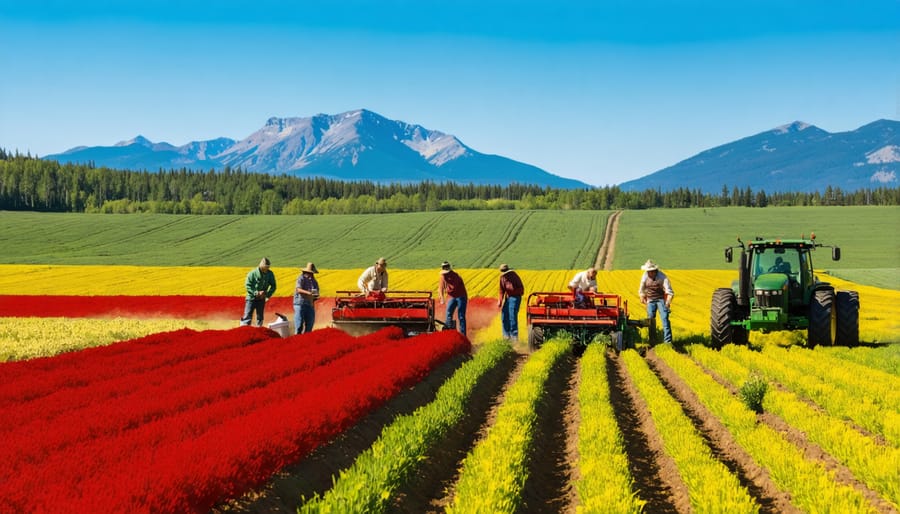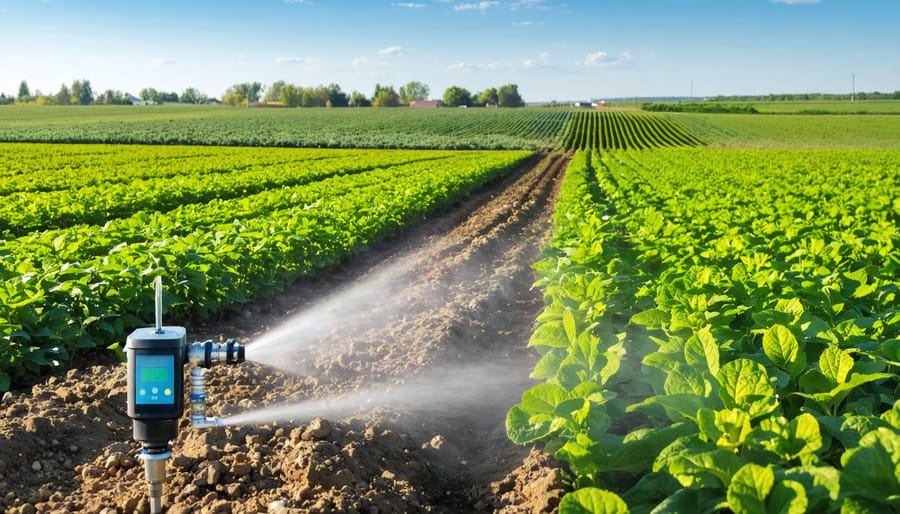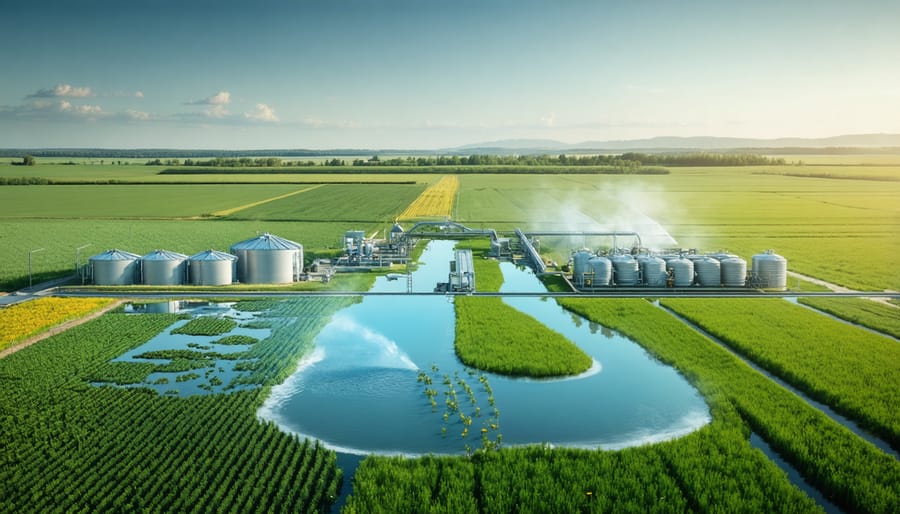In the heart of Canada’s agricultural landscape, the supply chain that connects farm to fork has become increasingly complex, yet critically important for our food security and economic prosperity. From the wheat fields of Alberta to the processing facilities in urban centers, modern agricultural supply chains represent a sophisticated network of producers, processors, distributors, and retailers working in concert to deliver fresh, safe food to consumers.
Today’s agricultural supply chains face unprecedented challenges and opportunities. Climate variability, technological advancement, and shifting consumer preferences are reshaping how we think about food production and distribution. For Canadian farmers and agricultural professionals, understanding and optimizing these supply chains isn’t just about efficiency—it’s about building resilient, sustainable food systems that can weather future challenges while meeting growing global demand.
Digital innovation, blockchain technology, and precision agriculture are revolutionizing traditional supply chain models, offering new ways to track products, ensure quality, and reduce waste. These advancements, combined with Canada’s strong agricultural foundation and commitment to sustainability, position our farmers and agribusinesses to lead the way in developing next-generation supply chain solutions that benefit producers and consumers alike.
This transformation in agricultural supply chains represents both a challenge and an opportunity for Canadian agriculture, demanding new skills, investments, and partnerships while opening doors to improved profitability and environmental stewardship.
The Power of Local Agricultural Supply Chains
Environmental Benefits of Short Supply Chains
Short supply chains in agriculture offer significant environmental advantages for Canadian farmers and their communities. By reducing carbon emissions through decreased transportation distances, local agricultural systems can lower their environmental impact substantially. Studies show that produce traveling less than 100 kilometres typically generates 50% fewer greenhouse gas emissions compared to conventional supply chains.
Here in Alberta, farmers implementing short supply chains have reported up to 40% reduction in fuel consumption for transportation. This improvement comes from eliminating multiple handling stages and reducing the need for energy-intensive cold storage facilities. Additionally, shorter supply chains often encourage more sustainable farming practices, as producers work directly with local markets and receive immediate feedback from consumers.
Local food systems also help preserve biodiversity by supporting varied crop production instead of monoculture farming. When farmers grow for nearby markets, they can choose varieties based on taste and nutrition rather than shipping durability, leading to better soil management practices and reduced pesticide use. This approach creates a more resilient agricultural system while protecting our natural resources for future generations.
Economic Advantages for Alberta Farmers
Alberta farmers implementing efficient supply chain practices are experiencing significant economic benefits, with many reporting profit margin increases of 15-25% through direct-to-consumer sales and optimized distribution networks. Local food markets in communities like Lethbridge and Red Deer have seen a 40% growth in vendor participation over the past three years, creating new revenue streams for agricultural producers.
Collaborative initiatives, such as the Southern Alberta Farm Collective, have helped reduce transportation costs by up to 30% through shared logistics and bulk purchasing power. Farmers participating in these networks report average savings of $12,000 annually on equipment and storage facilities through resource sharing.
The adoption of digital supply chain management tools has enabled Alberta farmers to better predict market demands and adjust production accordingly, reducing waste by approximately 20% and increasing overall revenue. Additionally, local processing facilities have created over 500 new jobs in rural communities, contributing to economic stability and growth.
By shortening the supply chain, farmers are capturing a larger share of the food dollar, with some reporting returns of up to 80 cents on the dollar compared to traditional distribution channels’ 20 cents. This increased profitability has led to reinvestment in farm operations and community development.
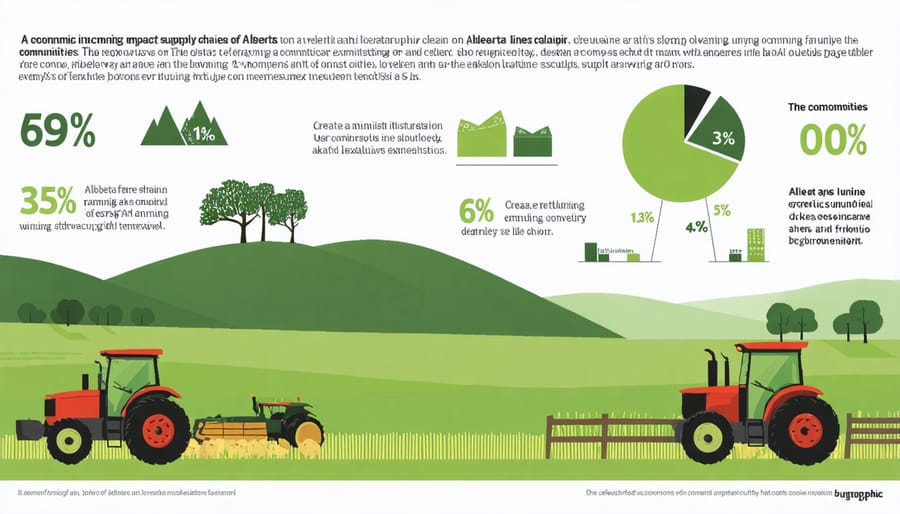
Building Successful Local Supply Networks
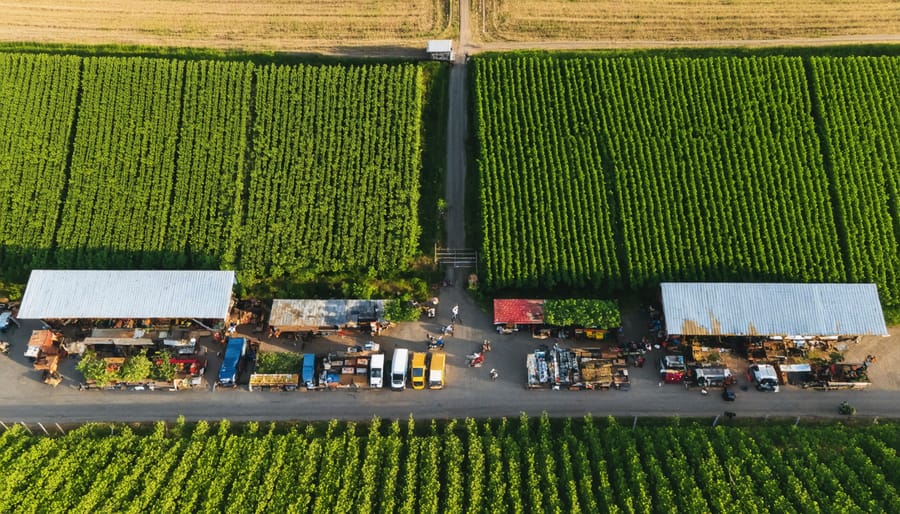
Direct-to-Consumer Models
Alberta’s direct-to-consumer agricultural models have shown remarkable success, particularly through farmers’ markets and Community Supported Agriculture (CSA) programs. The Calgary Farmers’ Market, operating year-round with over 75 local vendors, serves more than 20,000 customers weekly and generates approximately $12 million in annual sales. Similarly, the Old Strathcona Farmers’ Market in Edmonton has become a cornerstone of local food distribution, connecting over 130 producers directly with urban consumers.
Notable CSA success stories include The Farm of Abe and Mary near Lacombe, which serves 200 member families through their seasonal vegetable program. Their innovative payment structure allows members to choose between full-season commitments or flexible monthly subscriptions. Medicine Hat’s Prairie Fields Farm has pioneered a hybrid model, combining traditional CSA boxes with an online marketplace, reaching 150 households weekly during peak season.
These direct-to-consumer channels have proven particularly resilient during supply chain disruptions, with many Alberta farmers reporting 30-40% increases in CSA membership since 2020. The growth demonstrates how local food systems can effectively bridge the gap between producers and consumers while ensuring fair compensation for farmers.
Local Distribution Partnerships
Building strong partnerships with local retailers and restaurants is crucial for Alberta farmers looking to strengthen their agricultural supply chains. Many successful farmers in the region have found that establishing direct relationships with nearby grocery stores, farmers’ markets, and dining establishments creates reliable distribution channels while supporting the local economy.
For example, the Southern Alberta Local Food Initiative has helped connect over 50 farmers with neighbourhood retailers, resulting in fresher produce reaching consumers and better profit margins for producers. To develop these partnerships, start by reaching out to businesses within a 100-kilometre radius of your farm. Prepare professional product presentations highlighting your growing practices, delivery capabilities, and pricing structure.
Restaurants particularly value consistent quality and reliable delivery schedules. Consider partnering with other local farmers to ensure year-round supply and shared transportation costs. The Alberta Farm Fresh Producers Association offers networking events where you can meet potential partners and learn from successful distribution models.
Remember to formalize agreements with clear terms on pricing, delivery schedules, and quality standards. This protects both parties and builds trust for long-term collaboration. Many farmers find success by starting with smaller orders and gradually scaling up as the partnership strengthens.
Technology Integration
Modern agriculture in Alberta is increasingly embracing digital solutions to streamline operations and enhance efficiency. From smartphone apps tracking crop yields to advanced sensor systems monitoring storage conditions, technology is revolutionizing how we manage agricultural supply chains. Local farmers are adopting digital supply chain tracking systems that provide real-time updates on product movement and quality.
Popular platforms like FarmLink and AgriRecall help producers connect directly with buyers, reducing intermediaries and improving profit margins. These digital tools enable better inventory management, precise delivery scheduling, and enhanced quality control throughout the supply chain. Weather monitoring systems integrated with supply chain software help farmers make informed decisions about harvest timing and storage conditions.
Many Alberta farmers are using cloud-based management systems that synchronize data across multiple devices, allowing team members to access critical information from anywhere. These platforms often include features for documentation, compliance tracking, and automated reporting, helping farms meet regulatory requirements while maintaining efficient operations.
The adoption of these technologies has shown promising results, with many farms reporting reduced waste, improved delivery times, and better customer satisfaction.

Real Success Stories: Alberta’s Local Supply Champions
The Medicine Hat Food Hub Initiative
The Medicine Hat Food Hub Initiative stands as a shining example of how regional food distribution networks can transform local agricultural supply chains. Launched in 2019, this innovative project connects over 50 producers within a 150-kilometre radius of Medicine Hat, Alberta, creating a robust network that serves both urban and rural communities.
The hub operates as a centralized collection and distribution point, enabling small and medium-sized farms to aggregate their products and access larger markets more efficiently. Local farmers report an average 30% increase in revenue since joining the network, while reducing individual transportation costs by approximately 40%.
What makes this initiative particularly successful is its hybrid model of both physical and digital infrastructure. The hub utilizes a user-friendly online ordering system where producers can list their available products, while buyers, including restaurants, schools, and retailers, can place orders directly. The physical warehouse, equipped with proper storage facilities including cold storage units, ensures product quality and extends shelf life.
The hub also provides valuable support services, including food safety training, marketing assistance, and logistics coordination. This comprehensive approach has helped create a more resilient local food system, with 85% of participating producers reporting improved market access and stronger community connections.
The Medicine Hat model demonstrates how strategic coordination and shared resources can help overcome traditional supply chain barriers while supporting local agricultural communities.
Red Deer Valley Farm Collective
The Red Deer Valley Farm Collective, established in 2018, demonstrates how collaborative farming practices can strengthen agricultural supply chains in Alberta. This group of 12 family farms, spanning 4,000 hectares across central Alberta, has revolutionized local food distribution through shared resources and coordinated production planning.
By implementing a centralized distribution hub in Red Deer, the collective has reduced individual transportation costs by 40% and decreased food waste by 35% compared to their previous independent operations. Members coordinate planting schedules and crop varieties, ensuring steady supply throughout the growing season while maintaining crop diversity.
The collective’s success stems from their innovative approach to shared equipment ownership and maintenance. Instead of each farm maintaining expensive machinery, members pool resources to purchase and maintain essential equipment. This model has reduced individual farm operating costs by an average of 25%.
Their digital inventory management system, developed in partnership with local tech firms, enables real-time tracking of produce from field to market. This transparency has strengthened relationships with regional retailers and restaurants, resulting in stable, premium pricing for their products.
The collective also operates a successful CSA program serving 500 families in central Alberta, demonstrating how coordinated supply chain management can benefit both producers and consumers. Their model has become a blueprint for other farming communities across Canada seeking to enhance their market position through cooperation.
Overcoming Common Challenges
Seasonal Production Management
Managing seasonal production in Alberta’s agricultural landscape requires strategic planning and adaptable solutions to maintain consistent supply throughout the year. Successful farmers often implement a combination of approaches, including crop rotation schedules, greenhouse operations, and storage facilities to bridge seasonal gaps.
For grain producers, utilizing modern storage bins with temperature monitoring systems helps maintain crop quality during winter months, ensuring steady market supply. Many Alberta farmers have found success with controlled atmosphere storage, which can extend produce shelf life by up to six months.
Diversification plays a crucial role in year-round supply management. Consider partnering with greenhouse operators or investing in season-extension technologies like high tunnels. These structures can extend growing seasons by 4-6 weeks on either end, providing fresh produce when field production isn’t possible.
Local success stories include the Lacombe area farmers who coordinate planting schedules within their community to maintain consistent vegetable supply to regional markets. By staggering production and sharing resources, they’ve created a more resilient supply chain that benefits both producers and consumers.
Remember to factor in climate patterns and frost dates specific to your region when planning seasonal transitions. Working with agricultural extension services can help optimize your production calendar for maximum efficiency.
Storage and Distribution Infrastructure
Effective storage and distribution infrastructure forms the backbone of a successful agricultural supply chain in Alberta. Modern temperature-controlled facilities, strategically located across the province, help maintain product quality from harvest to market. Many Alberta farmers are implementing circular supply chain solutions that integrate smart storage systems with efficient distribution networks.
Local grain elevators and cold storage facilities are being upgraded with automated monitoring systems that track temperature, humidity, and product quality in real-time. These improvements have helped reduce post-harvest losses by up to 25% for many producers in the region. The Alberta Grain Terminal in Edmonton, for example, now uses IoT sensors to maintain optimal storage conditions for various crop types.
Distribution networks are evolving too, with many farmers joining cooperative transportation systems that share resources and reduce costs. These networks utilize route optimization software and coordinate deliveries to maximize efficiency. Several successful farming operations in Red Deer and Lethbridge have implemented hybrid storage solutions that combine traditional silos with modern automated systems, proving that blending conventional wisdom with new technology can yield excellent results.
Building Consumer Trust
Building consumer trust in agriculture requires a commitment to transparency and consistent community engagement. Alberta farmers have found success by implementing open-farm days, where consumers can visit and learn about agricultural operations firsthand. These events, combined with clear labeling practices and digital tracking systems, help demonstrate the journey from field to table.
Local farmers’ markets provide excellent opportunities to develop direct relationships with consumers. By sharing stories about sustainable farming practices and waste reduction strategies, producers can educate customers while building lasting connections. Many Alberta farmers have successfully used social media platforms to showcase their daily operations and respond directly to consumer questions.
Certification programs and quality assurance measures also play a crucial role in building trust. Third-party verification of farming practices, food safety protocols, and environmental stewardship helps consumers feel confident in their purchasing decisions. Regular community updates through newsletters and local media coverage further strengthen these relationships, creating a transparent and trustworthy agricultural supply chain that benefits both producers and consumers.
Building a resilient local agricultural supply chain isn’t just about improving business operations – it’s about strengthening our farming communities and ensuring food security for future generations. Throughout Alberta, we’ve seen how farmers who embrace local supply chain strategies have created more sustainable and profitable operations.
The key to success lies in starting small and scaling gradually. Begin by mapping your current supply chain partners within a 100-kilometre radius and identify potential local collaborations. Consider joining or establishing a regional farmers’ cooperative to share resources and distribute costs. Many Alberta farmers have found success by implementing digital tracking systems, starting with basic inventory management and expanding to more comprehensive solutions.
Remember that building strong relationships with local processors, distributors, and retailers is crucial. Regular communication and clear expectations help create lasting partnerships that benefit everyone involved. Don’t forget to leverage existing agricultural networks and support services – organizations like local agricultural societies and extension services can provide valuable guidance and connections.
Take action today by:
– Conducting a supply chain audit of your operation
– Identifying three potential local partners
– Developing a six-month implementation timeline
– Starting conversations with neighbouring farms about shared resources
– Exploring technology solutions that fit your scale
By focusing on these practical steps and maintaining a community-minded approach, we can build more resilient local agricultural supply chains that serve our farms and communities for years to come.




